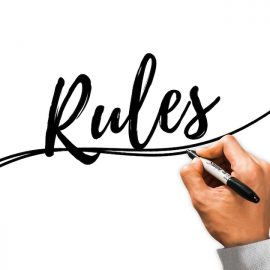
What’s emotional avoidance? How do we push down our emotions?
According to David R. Hawkins, most of us carry unhelpful emotions because we fear them. Instead of confronting them, we avoid dealing with the emotions, so they stay with us.
Let’s look at ways we unhealthily avoid negative emotions.
How We Avoid Dealing With Emotions
Hawkins says that every emotion has an energy frequency, and the higher the frequency, the more positive the emotion. Furthermore, similar energy frequencies are attracted to each other. Therefore, if you’re constantly practicing emotional avoidance or feeding into these emotions, those emotions will attract more negativity. You’ll be unhappy and less successful in all aspects of life: relationships, finances, and health.
(Shortform note: This concept of the energy you put out coming back to you is similar to the Law of Attraction, as described in Rhonda Byrne’s The Secret. However, Byrne focuses on thoughts instead of emotions—she states that your thoughts have an energetic frequency that beckons other sources with the same energetic frequency. When you focus on a thought and send its energy out, the universe sends the same frequency back to you. Therefore, it’s important to focus your thoughts on what you want to happen. If you focus your thoughts on what you don’t want—or you’re holding on to negative emotions—the universe will send you a negative outcome.)
In this section, we’ll examine the three most common—and ineffective—ways we avoid confronting our emotions:
- Distracting ourselves from our feelings
- Burying our feelings
- Sharing our feelings with others
Method #1: Avoiding Emotions Through Distraction
Hawkins says some people avoid unhelpful and uncomfortable feelings using external distractions. In today’s world, there’s no shortage of distractions that allow us to ignore our inner worlds. For example, you might open Instagram whenever you feel sad—scrolling for hours prevents you from diving into that feeling and thinking about why you’re sad.
Though distraction may provide short-term relief from negative emotions, it ends up taking more energy from us than addressing the feeling would. Even if we ignore the feeling, it doesn’t go away, so we end up carrying its negative energy around with us. Over time, this hurts us mentally and physically (ideas we’ll explore later in the guide). Ignoring our feelings also prevents us from connecting deeply with other people and improving ourselves, as we’re spending all our energy avoiding our emotions instead of opening ourselves up to positive opportunities and relationships.
| Further Drawbacks and Benefits of Distraction As Hawkins suggests, the advent of smartphones and other digital devices has introduced countless distractions that interrupt daily life. These technological diversions don’t just help you avoid your emotions—some research indicates that they can also impede your ability to concentrate. When your attention is always divided, your brain is in a state of constant alertness because your body produces more of the stress hormones cortisol and adrenaline. Your brain becomes used to looking for new stimuli, and there’s a constant temptation to check your devices. Not all distractions are bad, though—some experts argue that temporary, healthy distractions can help you cope with difficult emotions, especially when those emotions arise from mental health disorders such as anxiety and PTSD. When you’re feeling an emotion that’s too strong for you to cope with at that moment, healthy distractions can divert your attention long enough for the feeling to ebb to an intensity you’re better able to manage. Additionally, such distractions can prevent you from turning to unhealthy coping mechanisms, such as drugs and alcohol. Healthy distractions might include reading a book, calling a loved one, meditating, or doing a chore. This distraction strategy is a form of down-regulation, which is a type of emotion regulation wherein you lessen the intensity of an emotion to make it easier to handle. Rather than making connecting with others more difficult (like unhealthy forms of distraction), down-regulation can help prevent you from doing or saying things that hurt your relationships because you’re too emotional to act constructively. |
Method #2: Burying Emotions Deep Inside Ourselves
Another method we use to avoid dealing with uncomfortable emotions is burying them inside or deeply internalizing them. Hawkins explains that we typically do this when we’re unsure what to do with a feeling, we’re afraid of it, or we feel guilty about it. For example, you might bury your jealousy of your friend’s success because acknowledging the emotion makes you feel like a bad friend.
(Shortform note: To recognize when you’re internalizing your negative emotions, notice when you engage in the following behaviors: First, you frequently talk badly about yourself. You might blame or punish yourself for perceived failure, engage in negative self-talk, or withhold things that bring you joy. Internalizing behavior may also manifest as self-isolation, frequent nervousness, or difficulty concentrating.)
Hawkins notes that burying feelings can happen with or without our conscious awareness. When it’s conscious, we endure the feeling but act as if it isn’t there. Despite our efforts, the feeling usually manifests later as mental and physical problems such as irritability and headaches.
(Shortform note: Pretending that a negative feeling doesn’t exist provokes a physical response because it signals to your brain that the feeling is dangerous or unwelcome. When your brain senses danger, it prepares your body for fighting or fleeing through effects such as tense muscles, a fast heart rate, and shallow breathing. Staying in the fight-or-flight state for too long can lead to chronic pain (like frequent headaches) and mental health issues (like anxiety and depression) that cause chronic stress and irritability.)
When we unconsciously push away a feeling, it’s typically because we feel too much shame and anxiety to experience it consciously. To protect us, our minds deny the feeling before we’re even aware of it.
(Shortform note: Some experts argue that many Americans feel anxious and ashamed about negative feelings because they equate good self-esteem with happiness. They feel that if they’re unhappy, there’s something wrong with them. However, dismissing your negative feelings is dismissing an important part of who you are and how you experience the world, which actually worsens your self-esteem. To maintain a better relationship with yourself, you must accept all of your feelings—and consequently all parts of yourself—not just the happy ones.)
Method #3: Sharing Feelings With Other People
Finally, Hawkins argues that we sometimes avoid dealing with feelings by sharing them with others. This sharing might happen verbally or through our body language. We often do this because we think it will make us feel better.
However, sharing an unhelpful emotion doesn’t actually release us from it, contrary to what many people believe. Instead, it relieves just enough of the feeling’s weight to allow us to bury the rest of it and avoid dealing with its root cause. Additionally, putting our feelings on others can damage our relationships, as the other person then has to find a way to deal with the feeling as well. The negative feelings can build up and strain our connection with the other person.
| Sharing Negative Emotions Can Make You Feel Worse In Chatter, Ethan Kross also warns that sharing emotions and seeking support from other people can sometimes make you feel worse, adding that doing so increases your negative self-talk (your inner voice). Support-seeking often results in what psychologists call co-rumination: when the person supporting you asks too many questions about your challenge. Excessive questioning makes you re-experience the pain of the challenge and related, painful memories. This is because brains process thoughts by making associations: When you recall one negative memory, your brain resurfaces other, related negative memories. When you re-experience all these memories, your negative self-talk grows louder, intensifying your negative emotions. Likewise, other research supports the idea that venting negative emotions can have mixed results. It can make you feel better by alleviating some of your stress and garnering sympathy and reassurance from the person you’re venting to. However, frequently venting to people can wear them out emotionally (as Hawkins suggests), making them feel stressed and resulting in them responding with less empathy each time. To avoid damaging your relationships through venting, show appreciation for others’ support, pay attention to cues that they’re emotionally fatigued, and offer to reciprocate when they need someone to talk to. |






